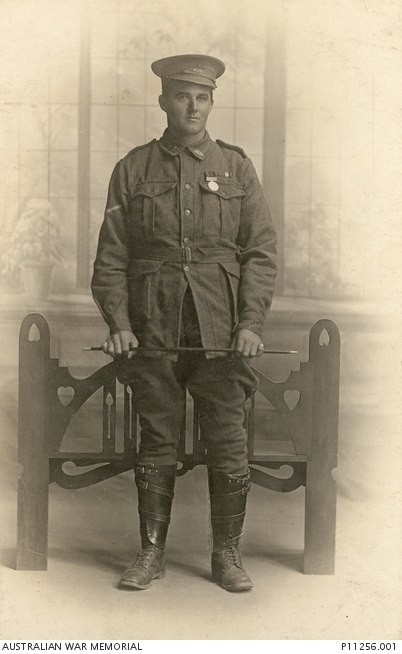| Accession Number | P11256.001 |
|---|---|
| Collection type | Photograph |
| Object type | Black & white - Digital file TIFF |
| Maker |
Spurling Studios |
| Place made | Australia: Tasmania, Launceston |
| Date made | c January 1917 |
| Conflict |
First World War, 1914-1918 |
| Copyright |
Item copyright: Copyright expired - public domain
|
Studio portrait of Lance Sergeant [Lance Corporal] Harvey Stanley Hyde Blackburn, wearing a medal ...

Studio portrait of Lance Sergeant [Lance Corporal] Harvey Stanley Hyde Blackburn, wearing a medal and ribbons from his service in the Boer War. An engine driver with the Tasmanian Railway Department, he was involved in a railway accident prior to enlistment which resulted in 18 months in hospital, six operations and the amputation of his left foot. During his recovery Blackburn received several communications from the military authorities asking him to present himself at camp. He wrote back explaining his circumstances and restating his willingness to serve. He was told to report when he had recovered.
While Blackburn was convalescing, the Railway Units were formed and on applying he was told by the officer in charge that his experience both on the railways and in South Africa would make him an ideal candidate. He presented himself to the doctor at Devonport and persuaded him to send him on to to the medical staff at camp. At the medical check up Blackburn bared only his good leg, keeping the artificial leg covered and slightly under the table behind him. He proceeded to distract the doctor with questions and then reminded him to check his other leg, but instead presented the good leg again. Blackburn almost succeeded in the ruse until another doctor walked in and spotted what he was doing. An argument ensued, with the second doctor arguing that Blackburn was useless. Blackburn pointed out that if the doctor had been more observant he would have noticed that the leg was clearly marked on his attestation papers. He also mentioned the railway officer's testimony and argued that he was perfect for the front line as he couldn't retreat as quickly as the others and would be forced to stay with his locomotive and hold his ground. The doctors then made him remove his trousers and walk around the room. The first doctor declared that he would pass fit a thousand men like Blackburn and he enlisted on 10 January 1917 with an A1 rating. He notes proudly that he never missed a parade or route march and his drill instructors never realised the extent of his disability, assuming he was suffering from a bad corn.
Serving in France with 4 Broad Gauge Railway Operating Company, Blackburn drove engines around Peronne and in Flanders without mishap. The only problem he experienced with his leg was a severe numbing in the coldest months. These conditions caused his calf to shrink from 16 to 9 inches. On his return to Australia Blackburn discarded the leg for one with a better fit and donated the original to the Memorial in 1925. Blackburn maintained that his was the only artificial leg accepted for service in the AIF, and possibly the entire Allied Forces.
This portrait is taken after he enlisted and the image has been altered to make the leg with the prosthesis look slimmer and more like his right leg.
